Many species of insects or mites attack Georgia landscape plants. Homeowners have difficulty controlling these pests because they often are either not aware of the problem until both the infestation and the damage are extensive or they may apply insecticides improperly or at the wrong time.
An effective pest control program on landscape plants begins with proper plant selection. First, select plants that are less prone to insect problems when designing, purchasing or replacing landscape plants. Second, closely inspect landscape plants for developing pest populations on a weekly basis during the growing season. Remember that some insects and mites are minute in size and are frequently found on the undersides of leaves. A close and thorough inspection is necessary to detect these pests. Finally, if you find a developing pest population that you cannot identify, ask your local county Extension office or a reliable nursery for assistance. You must know what pests you have before trying to control the problem.
This publication provides brief descriptions of major groups of pests found on Georgia landscape plants (and the damage they cause) to assist with identification. Control strategies for these pests are presented in Table 1.
Sucking Pests

Sucking insect pests cause damage by removing sap from plant tissues. Symptoms of infestation include wilting of plant tissues, stunting, curling or distortion of new growth, chlorotic spots or stippling of the leaf surface, or a sticky substance or black fungal growth on the upper leaf surface. Common insects and mites causing this type damage include aphids, scale insects, mealybugs, lace bugs, whiteflies and spider mites.
Aphids

Aphids are small (about 1/4 inch in length), soft-bodied insects that vary in color from green to yellow to black. Some species are winged during certain times of the year. Generally, aphids can be recognized by their cornicles, a pair of tube-like structures projecting from the rear of their bodies.
Aphids secrete a honeydew substance that encourages the growth of black sooty mold on plant material. They are frequently found clustered together in large numbers on the backs of leaves or on the stems of new growth.
Scale insects and mealybugs
Scale insects are very small, soft-bodied pests that secrete a protective covering over their bodies. These coverings vary in color from white to red to black. Some are flattened while others are more turtle-shaped. This covering protects the scale and makes control difficult.
Scale insects are most easily controlled when insecticide applications are timed for the first instars or “crawler” stage of the scale.
Mealybugs are similar to scale insects; however, they secrete a white waxy material over their bodies. Mealybugs also move about on the host plant to feed. Mealybugs are most susceptible to insecticide applications when they are young and have not formed a thick covering over their bodies.
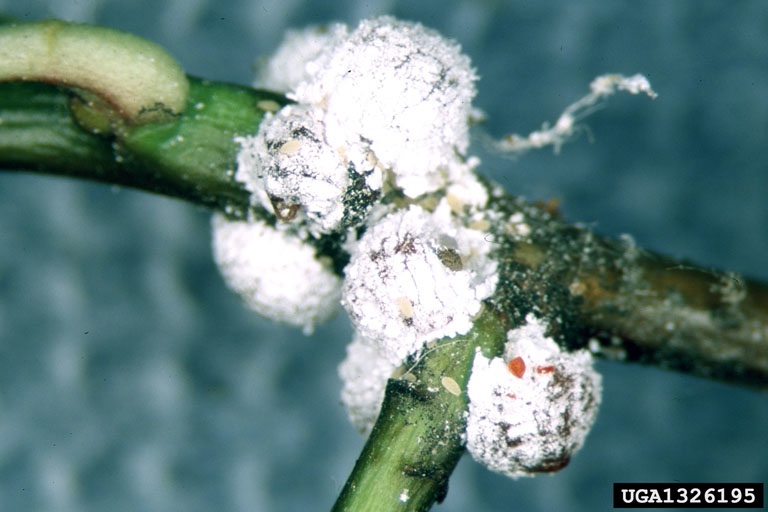
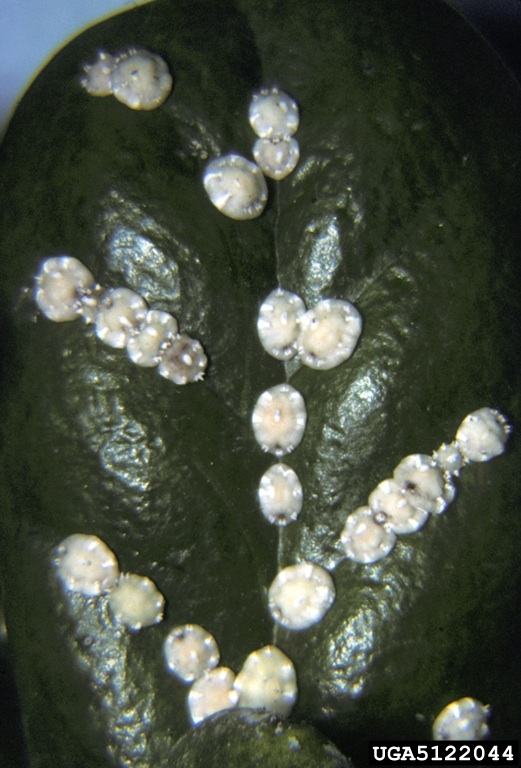
Lace bugs
Lace bugs get their name from the appearance of the area behind their head and wing covers. The area forms a lacelike covering over the body of the insect. They are 1/8 to 1/4 inch in length and are partially transparent.
Lace bug damage appears on the upper leaf surface as white to yellow chlorotic spots. The lower leaf surfaces will be cluttered with black spots and the old cast skins of immature lace bugs. Initiating control in the spring between March and May will reduce problems later in the season.

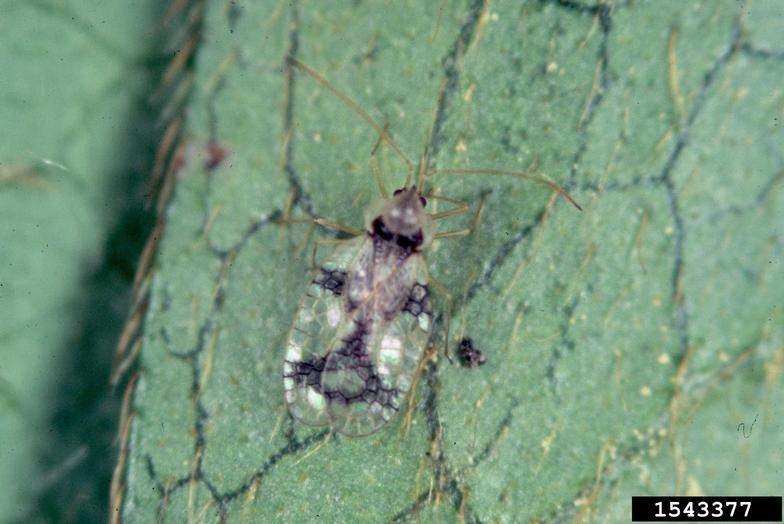
Whiteflies
Whitefly adults resemble small gnats. They range in size from 1/10 to 1/16 inch and have four broad, delicate, milk-white wings. The immature whiteflies are attached to the underside of leaves and resemble scale insects. They are oval, flattened and yellow to almost transparent.
Whiteflies secrete a honeydew substance that encourages the growth of black sooty mold on plant material. Whiteflies often occur in tremendous numbers and when a heavily infested plant is disturbed, the air is filled instantly with a white cloud of these insects.
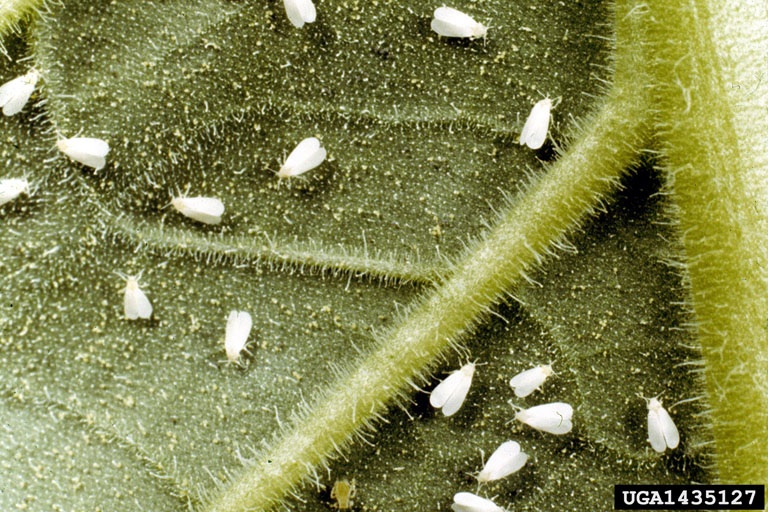
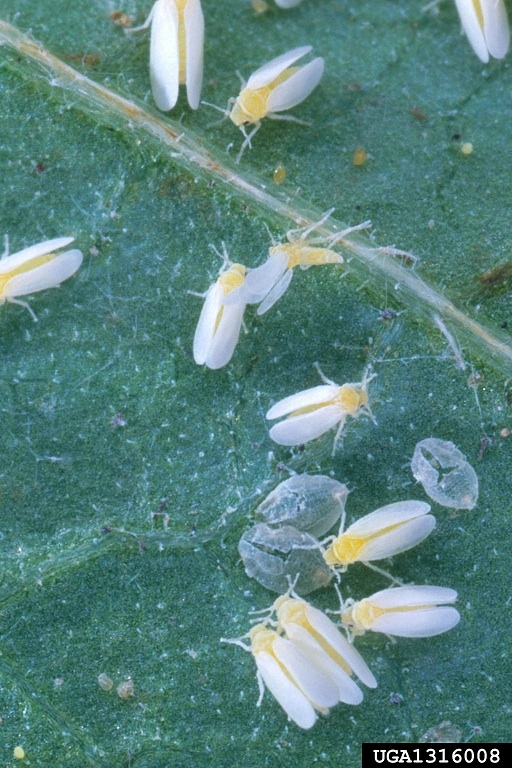
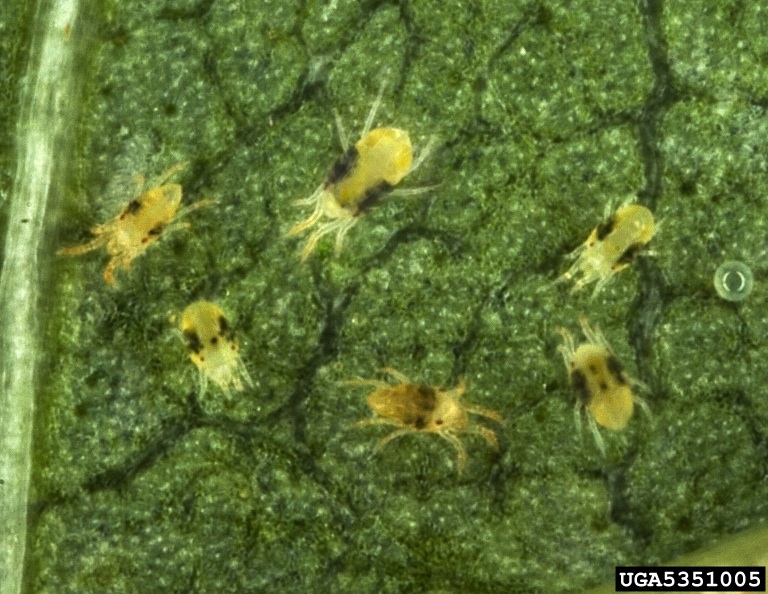
Spider mites
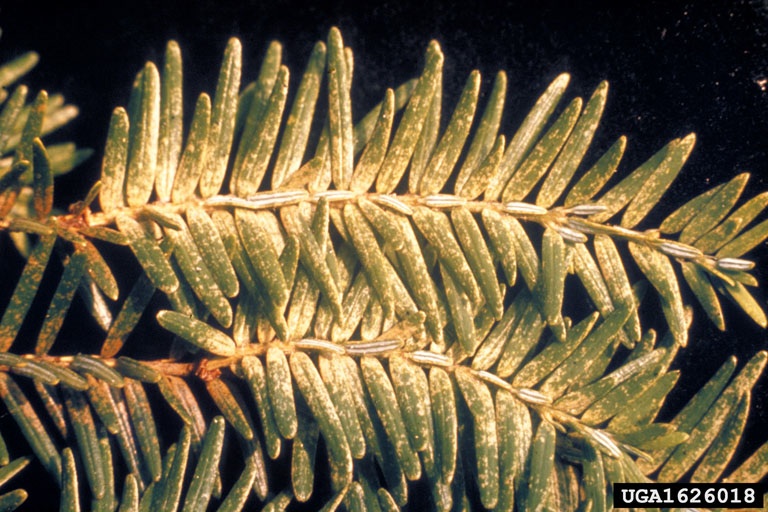
Spider mites are most often found on the backs of leaves. They are so small they can barely be seen with the unaided eye. The adults are oval-shaped and have eight legs and no antennae or wings.
A sign of their presence is a stippling appearance on the upper sides of leaves on broadleaf plants and a browning of needles on conifers. Sometime webbing is present.
Chewing Pests
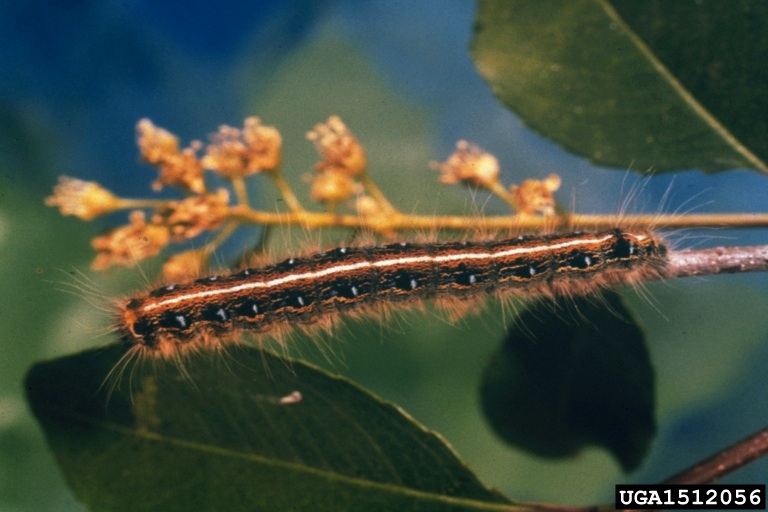
Chewing insect pests cause damage by consuming plant parts such as leaves and stems or burrowing in plant tissues, which damages the host plant.
Symptoms of chewing insect pests include holes in leaves, silvering of leaf tissue, complete removal of leaf tissues and burrowing in or around plant stems, branches or trunks.
Common insects causing this type of damage include tent caterpillars, webworms, bagworms, shadetree borers and other beetles.
Tent caterpillars
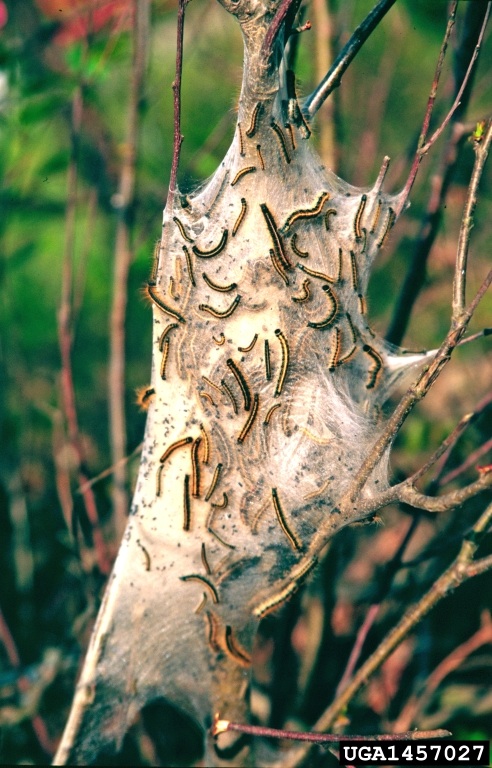
Tent caterpillars are attractively colored larvae that reach about 1 1/2 inches in length. They have a few long hairs on their bodies, mostly along the sides.
They are commonly seen in the early spring closely associated with the webs or “tents” they construct in the crotch of small limbs on their host plant. This tent serves as a refuge for the larvae at night and during rainy weather. They have only one generation per year.
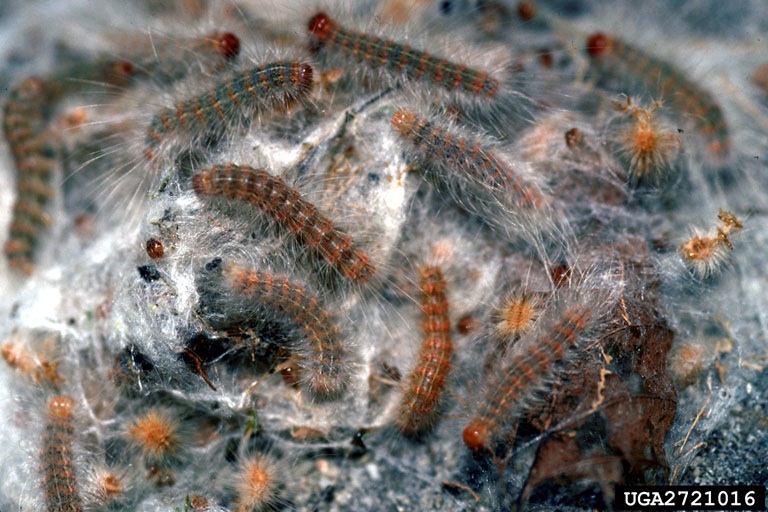
Fall webworms
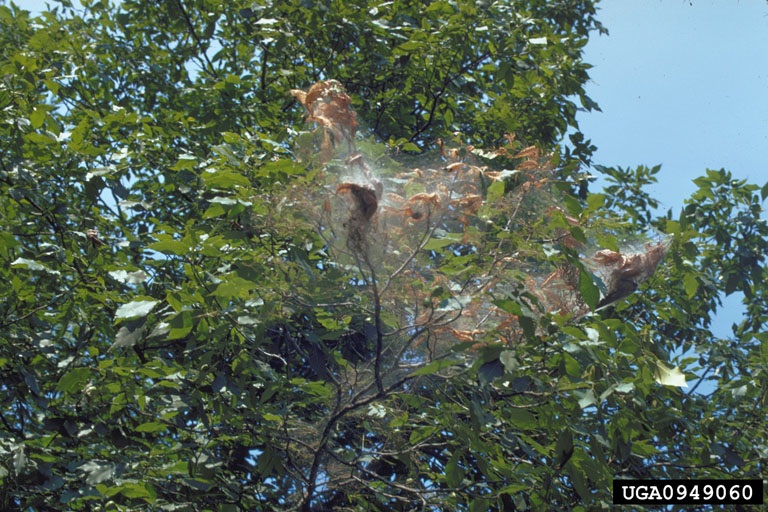
Webworm larvae are about 1 inch long when full grown and are pale yellow or green in color. A broad, dusky stripe runs down their backs, bordered on each side by a yellow stripe. They are covered with tufts of long whitish hairs.
These larvae can be found inside unsightly webs at the ends of branches on host plants. Georgia has three to four generations of webworms per year.
Bagworms
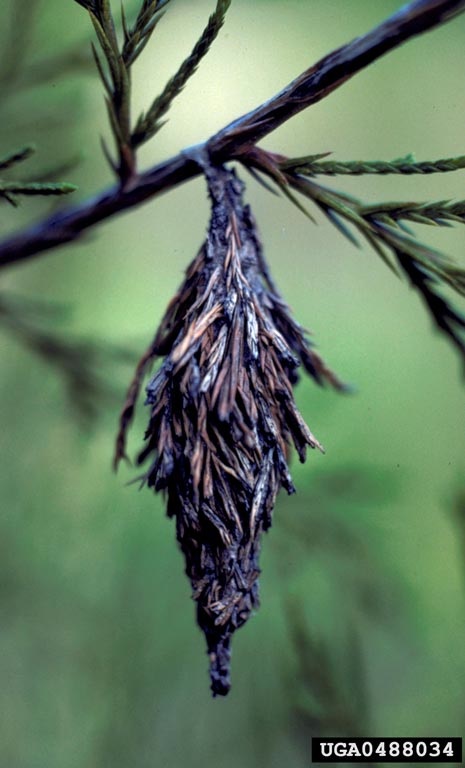
Bagworms construct and live inside a 1- to 2-inch long tough, tear-shaped portable silken case. These bags are the insects' most easily seen and identifiable feature.
Outside, the silken texture of the bag is somewhat concealed with layers of leaf, twig, and bark fragments. The bag has an opening at the larger end that allows the worm to partially crawl out to make repairs to its bag and eat.
Beetles
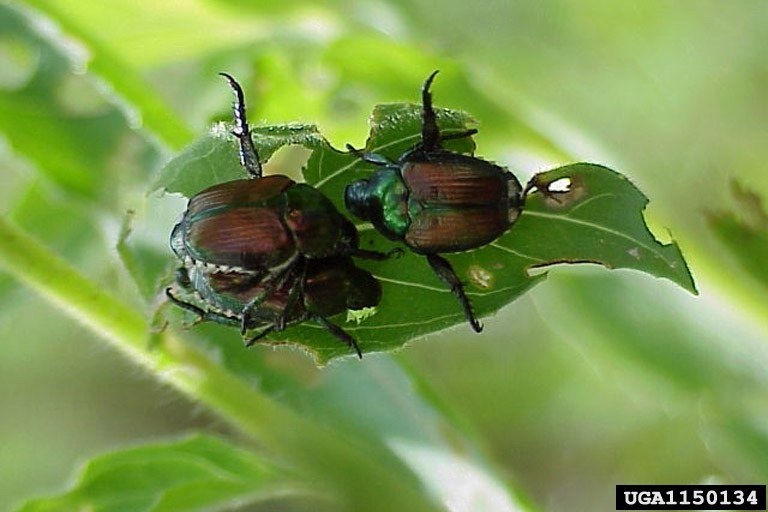
Several beetles, such as the elm leaf beetle, imported willow leaf beetle, flea beetle and Japanese beetle, attack trees and shrubs and cause feeding damage.
Damage first appears when the green parts of leaves are removed, leaving just the veins of the leaf tissue remaining. As damage accumulates, dry skeletonized leaves become obvious. Leaves take on a rusty, reddish-brown tint.
Boring Pests
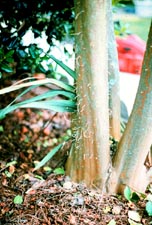
Asian ambrosia beetles
Most of these pests attack trees or shrubs that are already weakened or injured by transplant shock, drought, flooding, soil fills, mechanical damage or disease. The larvae are 1/4 inch to 2 inches in length, yellowish-white and legless.
They burrow or tunnel into the bark and sapwood of infested trees. They introduce and cultivate ambrosia fungus, which they feed on.
Sawdust and insect wastes are pushed out of the boring hole and look like toothpicks.
Table 1. Control strategies for major pests of Georgia landscape plants.
| Pests | Host Plants | Control Practices |
|---|---|---|
| Aphids | Many types of shrubs and trees. | (1) Inspect plants frequently. Look for lady beetles and other beneficial insect populations associated with aphids. (2) Aphids can be washed off plants with a strong stream of water when populations are light and/or beneficial insects are present. (3) Avoid applying excessive amounts of high nitrogen fertilizer, which stimulates succulent new growth that aphids prefer to feed on. (4) When insecticides are needed to control heavy populations, use insecticidal soaps, horticultural oils and products containing acephate (Orthene), malathion, imidacloprid, cyfluthrin or bifenthrin. Follow label directions. |
| Scale insects (armored scales, soft scales) |
All types of woody ornamentals and trees. |
(1) Select plant material that is not prone to scale infestation. (2) Inspect plants frequently. Look for lady beetles and other beneficial insect populations associated with scale infestation. (3) Prune heavily infested plant parts when possible. (4) Treat infested plants with insecticidal oils during the dormant season or with conventional sprays in spring and summer when young crawlers are actively moving on the plant. Application should cover both sides of leaves and all twigs and branches. Some products labeled for scale control include malathion, acephate (Orthene), carbaryl (Sevin), bifenthrin, cyfluthrin, resmethrin, insecticidal soaps and horticultural oils. |
| Lace bugs (azalea lace bug, hawthorn lace bug) |
Azalea, laurel, pyracantha, sycamore, hawthorn, quince, American elm, apple. | (1) Inspect susceptible plant material every week during the growing season for developing lace bug infestations. (2) Wash light infestations off the host plant with a strong stream of water. (3) When chemical control is necessary, use products containing acephate (Orthene), carbaryl (Sevin), malathion, cyfluthrin or bifenthrin. Repeated application at 10- to 14-day intervals may be necessary to maintain effective control. For the most effective control, time applications for early spring when the first generation is present. |
| Whitefly | Gardenia, crape myrtle, ligustrum, azalea and many other woody ornamentals and trees. | (1) Monitor susceptible plants weekly for developing whitefly infestations. Place yellow wooden panels coated with a sticky substance near host plants to monitor for whiteflies. (2) Use products containing acephate (Orthene), insecticidal soaps, malathion, resmethrin, imidacloprid, cyfluthrin, bifenthrin or horticultural oils to control whitefly. Often, three to four applications at five- to seven-day intervals are necessary to control heavy populations. Observe and follow label instructions and restrictions. |
| Spider mites | All types of woody ornamentals and trees. | (1) Inspect susceptible plants weekly during hot, dry periods for developing mite infestations. (2) Wash light infestations off the host plant with a strong stream of water. (3) When possible, remove and destroy heavily infested plant parts. (4) When chemical control is necessary, use products containing acephate (Orthene), bifenthrin, horticultural oils or insecticidal soaps. Often two to three applications at five- to seven-day intervals are necessary to control heavy populations. Observe and follow label instructions and restrictions. |
| Tent caterpillars | Plum, peach, apple, hawthorn, oaks, sweet gum and other trees. | (1) Inspect trees for egg masses during winter pruning. Remove and destroy egg masses. (2) Prune out webs when first noticed. (3) Destroy webs and crush caterpillars. (4) Time insecticide applications for presence of feeding caterpillars. Spot treat webs with products containing diazinon, Bacillus thuringiensis (Dipel), carbaryl (Sevin) or malathion. |
| Fall webworms | Plum, peach, apple, hawthorn, oaks, sweet gum, oak, pecan, hickory, other ornamental trees and shrubs. Broadleaf and coniferous trees and shrubs. | (1) Prune out and destroy webs. Crush caterpillars. (2) Prior to insecticide treatment, break up webbing material to allow insecticide penetration. Treat webs with products containing acephate (Orthene), Bacillus thuringiensis (Dipel) or carbaryl (Sevin). |
| Asian ambrosia beetles | Oak, pecan, hickory, other ornamental trees and shrubs. Crape myrtles, dogwoods, redbud and other shade trees. | (1) Follow proper watering, fertilizing and pruning practices. (2) Remove other stress factors from trees when possible. (3) Infested plant material cannot be treated and should be removed and disposed of. (4) Protect trees from infestation or re-infestation by using products containing bifenthrin or permethrin. Make first application in April and subsequent applications in late May, mid-July and late August. |
| Bagworms | Broadleaf and coniferous trees and shrubs. | (1) Remove and destroy all bags. (2) Treat infested plants when bags are first noticed with a product containing acephate (Orthene), carbaryl (Sevin) or Bacillus thuringiensis (Dipel). |
| Beetles (elm leaf beetle, imported willow leaf beetle) | Many shade and ornamental trees. | (1) Inspect trees frequently for beetle damage. (2) Insecticide applications are most effective when timed for the presence of young larvae or before large numbers of adults are present. Products containing carbaryl (Sevin) or acephate (Orthene) are effective. Repeated applications may be necessary to maintain control when beetles migrate in from surrounding areas. (3) Protect trees from infestation or re-infestation by using products containing bifenthrin or permethrin. Make first application in April and subsequent applications in late May, mid-July and late August. |
| Japanese beetle | Many shade and ornamental trees. | (1) Inspect trees frequently for beetle damage. (2) Japanese beetle traps are mostly useless. All they do is attract more beetles. (3) Treat infested plants with carbaryl (Sevin) or imidacloprid (Bayer Advanced products) when beetles are first observed. |
| Notice: Pesticide labels and registrations are subject to frequent revision. Before using any insecticide, refer to the label and confirm that the intended use is in accordance with labels uses and restrictions. See the current edition of the Georgia Pest Management Handbook for current control recommendations. | ||
1Agricultural and Natural Resources Agent, Gwinnett County Cooperative Extension
2Extension Entomologists
Status and Revision History
Published on Jan 01, 2002
Unpublished/Removed on Mar 12, 2009
Published with Minor Revisions on May 12, 2011
Published with Full Review on May 16, 2014
Published with Full Review on Aug 02, 2017
Published with Full Review on May 11, 2023


























































